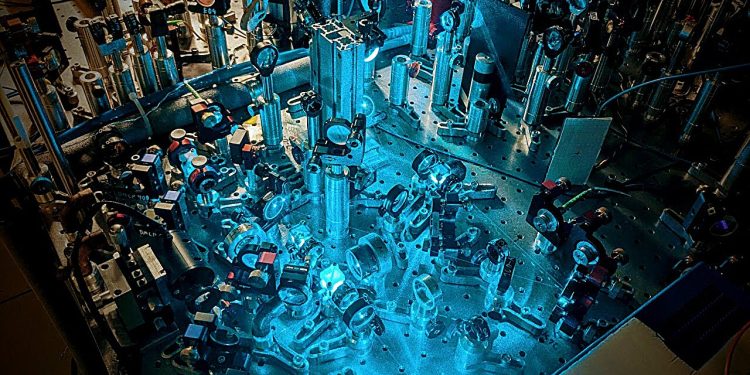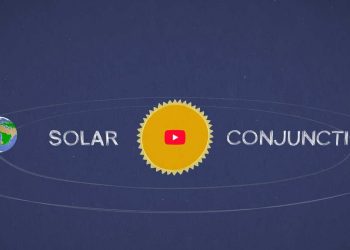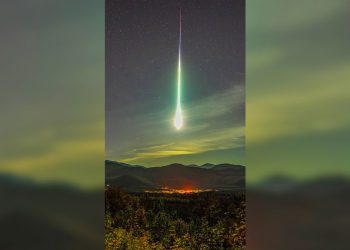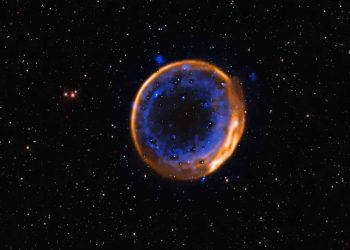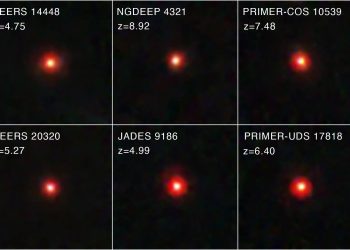Experimental setup to control the quantum radio antenna. Credit: Michal Parniak, University of Warsaw
A team from the Faculty of Physics and the Center for Quantum Optical Technologies at the University of Warsaw has developed a new type of fully optical radio receiver based on the fundamental properties of Rydberg atoms. The new type of receiver is not only extremely sensitive, but also allows internal calibration, and the antenna itself is powered only by laser light.
The results of the work, in which Sebastian Borówka, Mateusz Mazelanik, Wojciech Wasilewski and Michał Parniak participated, were published in Natural communication. They open a new chapter in the technological implementation of quantum sensors.
In today’s society, enormous amounts of digital information are transmitted around us every second. Much of it is transmitted by radio, that is, by electromagnetic waves. For a very long time, amplitude modulation has been used to encode information, sending stronger and weaker waves.
Newer protocols also change the phase of the waves, that is, the delay of their vibration from the agreed clock cycle. Every modern transmitter and receiver is equipped with precise metronomes that determine the clock cycle used to transmit and decode the waves. In technical jargon this is called superheterodyne detection.
Information hidden in the waves
These technologies can be easily explained with an analogy. Professor Wojciech Wasilewski suggests imagining receiving sea waves: to receive the information encoded in the waves while standing on the beach, one must note both the force of the waves (the depth with which they crash onto the beach) and the exact moments when the waves hit the shore.
The same goes for “transmitting” waves with a teaspoon in a cup of tea: if we were a WiFi transmitter, we would have to dip the teaspoon at a regular rate, in time with the control circuits. However, we should not act immediately on every call, but with a certain delay, each time in the same way.
Every few thousand periods we had to change the depth and delay, that is, the part of the rhythm at which we dip the teaspoon. This would give us quadrature amplitude modulation (QAM).
In practice, metal antennas are commonly used to receive transmissions, which redirect the energy of incoming waves back to the receiver. Energy absorption allows electronic measurement of wave amplitude and phase. Today, this measurement is accomplished by converting (mixing) frequencies.
The electrical signal from the antenna, which vibrates billions of times per second (at a frequency of gigahertz), is directed to mixers, which allow demodulation, that is, the transfer of the amplitude and phase of very fast vibrations to lower frequency signals, vibrating only millions of times per second (at a frequency of megahertz).
At this stage, it is possible to easily separate adjacent channels that you do not wish to receive. Modern electronics can easily make digital voltage measurements tens of millions of times per second. These measurements make it possible to reconstruct the complete waveform of the vibrations and, using digital signal processing algorithms, their amplitude and phase.

Fully optical quantum radio antenna: a rubidium glass cell powered by laser beams. Credit: Michal Parniak, University of Warsaw
Synchronized dance of atoms
As Dr. Michał Parniak explains: “In our experiments, we replaced the antenna and the electronic mixer with a new medium, a kind of artificial aurora borealis. »
A piece of rubidium was placed in a glass cell that had been carefully expelled from the air. Then the atoms were released from the piece of rubidium and flew into the glass cell. They were then harnessed for a carefully planned performance. Each rubidium atom has a relatively free electron, which is subject to a complex dance choreography around the atomic nucleus and the atomic nucleus made up of the remaining 36 electrons.
Three different lasers play the role of music in this dance. Their vibration frequency is ultra-precisely stabilized at the possible frequencies of electrons orbiting rubidium atoms, determined by the laws of quantum mechanics.
The electrons “hear” such a “melody” that they pass selected parts of the laser dance beats into a very, very distant orbit – in what are called Rydberg states. In these orbits, their trajectory is very easily bent by microwaves.
More precisely, by radio waves which punctuate the laser melody played. However, each electron in a Rydberg state – raised into a high orbit – cannot stay there indefinitely and must eventually fall like a decommissioned satellite. Electrons affected by radio waves follow a different path and emit different infrared radiation than lasers, making them easy to detect.
More importantly, the phase of the microwaves is reflected in the phase of the emitted infrared radiation: if the radio waves “hit” earlier in a defined cycle, the electrons also fall a little earlier and emit radiation earlier.
The challenge solved in the latest publication was to build a system to precisely control the lasers and the electron dance so that the rate of electron movement never slows down or speeds up uncontrollably. For this purpose, a series of “metronomes” was used.
For each laser, a special vacuum tube was built, finished with very good mirrors, with which the light is reflected several thousand times. Such a tube, called an optical cavity, like an organ pipe or violin string, selects only vibrations of a specific frequency.
In the tubes used here, two fields vibrate simultaneously: a stabilized laser and a reference laser, the frequency of which is precisely electronically matched to the period of the lowest orbit during which electrons can orbit the core and core of rubidium. Additionally, a special crystal is used to mix the frequencies to produce reference infrared radiation from the lasers used.
The crystal is not sensitive to microwaves, so the infrared it emits has a slightly different frequency than that emitted by rubidium atoms. Practical measurements required the use of an additional reference laser, against which the infrared emitted by the atoms and the reference infrared coming from the mixing crystal were measured.
Such a relative measurement – an optical heterodyne – made it possible to obtain the amplitude and phase of the fields studied. In turn, these can be used to directly calculate the amplitude and phase of the received microwaves.
Undetectable detection of radio fields
At the heart of the experiments presented, that is to say in the rubidium cell, there is no metallic element that conducts electricity and strongly disrupts radio waves. All it takes to convert radio waves into infrared radiation is rubidium vapor, a sealed enclosure and lasers.
In the future, the detector could take the form of a simple thickening on an optical fiber, through which all the necessary lasers would be fed, as well as the received infrared radiation, sent in the opposite direction into the optical fiber. The final measurements and corrections will be carried out even several tens of meters from the radio fields, allowing extremely discreet and non-invasive measurement and reception of the radio field.

Rubidium glass cell: miniaturized antenna of the future. Credit: Michal Parniak, University of Warsaw
This invention could have serious consequences for techniques for precise calibration of microwave fields. Thanks to non-invasive measurements, it will be possible to record weak fields without disturbing them simultaneously with a metal antenna. It is also possible to imagine such a microwave sensor being perfectly concealed as an electronic listening device. Unlike currently available electronic devices, it would be much more difficult to detect as a receiver of radio transmissions.
Scientists at the Center for Quantum Optical Technologies and the Faculty of Physics at the University of Warsaw have been designing and demonstrating new protocols for detecting microwave fields using Rydberg atoms for several years. The team succeeded in overcoming technical barriers and developing new detection methods offered by these revolutionary devices.
Scientists are involved in researching applications for this new technology, highlighting its ease of calibration, high sensitivity and measurement accuracy, as well as the prospects for device miniaturization.
Rapid technological development arouses the interest of foreign and international measurement standardization agencies, military institutes and space agencies, which in the future plan to place Rydberg sensors on satellites.
Since the beginning of 2025, the team led by Dr. Michał Parniak has also been commercializing this technology as part of a project commissioned by the European Space Agency.
The research is also one of the main results of the SONATA17 project funded by the National Science Center of Poland. The project “Quantum optical technologies” (FENG.02.01-IP.05-0017/23, 2024-2029) is carried out within the framework of the Measurement 2.1 International Research Programs program of the Foundation for Polish Science.
More information:
Sebastian Borówka et al, Optically polarized Rydberg microwave receiver enabled by hybrid nonlinear interferometry, Natural communications (2025). DOI: 10.1038/s41467-025-63951-9
Provided by the University of Warsaw
Quote: Quantum radio antenna uses Rydberg states for sensitive detection of all-optical signals (October 16, 2025) retrieved October 17, 2025 from https://phys.org/news/2025-10-quantum-radio-antenna-rydberg-states.html
This document is subject to copyright. Except for fair use for private study or research purposes, no part may be reproduced without written permission. The content is provided for informational purposes only.


